Door trim serves as both a functional and decorative element that frames your doorways while concealing the transition between walls and door jambs. From traditional Victorian elegance to sleek contemporary minimalism, the right trim choice can dramatically transform your space's character and visual appeal. Current trends favor either bold contrasting colors or seamless monochromatic schemes, with materials ranging from classic wood to modern MDF and composite options. Whether you're renovating an older home or updating a newer construction, thoughtful door trim selection creates architectural interest while reflecting your personal style and enhancing your home's overall design aesthetic.

1. Craftsman Style Door Trim with Thick Headers

The hallmark of Craftsman door trim features substantial horizontal headers that extend beyond the side casings, creating bold architectural interest. This style typically uses 4-6 inch wide boards with clean, straight lines that emphasize quality craftsmanship and natural materials. The thick header piece sits prominently across the top, often connecting multiple doorways for a continuous band effect around the room. Popular in early 1900s bungalows and Arts and Crafts homes, this trim style pairs beautifully with matching window casings and complements furniture with similarly chunky proportions. The substantial appearance makes doorways feel more important while maintaining the simplified elegance that defines the Craftsman aesthetic.
2. Modern Minimalist Flat Door Casing

Contemporary homes embrace flat door casing that creates clean, unobtrusive borders around doorways without competing with furnishings or architectural elements. This streamlined approach uses boards with no decorative profile or shape, resulting in crisp geometric lines that blend seamlessly with minimalist decor. The flat casing typically features mitered corners for sharp, precise joints that enhance the modern aesthetic. Popular finishes include matching the trim color to walls for a monochromatic scheme or choosing contrasting colors for subtle definition. This style works exceptionally well in open floor plans where visual continuity between spaces is essential for maintaining the clean, uncluttered feel.
3. Victorian Door Trim with Decorative Rosettes

Victorian-era door trim celebrates ornate craftsmanship through fluted casings paired with decorative rosette corner blocks that eliminate the need for precise mitered joints. The fluted trim features narrow vertical ridges running the length of the boards, adding texture and visual interest that catches light beautifully throughout the day. Rosettes traditionally showcase carved flower designs, though modern interpretations include geometric patterns, stars, or custom motifs. This elaborate style often incorporates plinth blocks at the base where trim meets baseboards, creating seamless transitions while adding layers of architectural detail. The rich, decorative approach perfectly complements period furniture and wallpaper patterns in formal settings.
4. Farmhouse Door Trim with Butted Headers

Farmhouse door trim embraces simplicity through straight-lined boards with butted header construction that creates a clean, welcoming appearance. The horizontal header piece rests directly on top of the side casings without mitered corners, often featuring a wider board that draws the eye upward and works well with higher ceilings. This uncomplicated approach typically uses 1x4 and 1x6 boards in crisp white paint or natural wood stains that highlight grain patterns. The style pairs beautifully with shiplap walls, barn doors, and rustic furniture while maintaining the unpretentious charm that defines farmhouse living. Additional decorative elements like small accent strips can enhance the header for extra visual interest.
5. Traditional Colonial Door Casing with Cove-and-Bead Profile

Colonial door casing embodies timeless elegance through the classic cove-and-bead profile that features subtle decorative curves without overwhelming traditional or formal interiors. The characteristic concave curve (cove) followed by a small rounded projection (bead) creates sophisticated shadow lines that add depth and dimension to doorways. This refined profile works equally well in both formal dining rooms and casual family spaces, adapting to various decorating styles while maintaining its inherent sense of quality and permanence. The proportions typically follow classical guidelines that relate to room height and door size, ensuring balanced appearances that complement rather than compete with other architectural elements in the space.
6. Contemporary Color-Drenched Door Trim

The modern color-drenching technique paints door trim the same shade as surrounding walls and architectural elements, creating seamless, unified spaces that feel larger and more sophisticated. This monochromatic approach works particularly well in smaller rooms where visual continuity helps expand the perceived space while allowing furniture and artwork to take center stage. Popular color choices include deep navy, forest green, or warm charcoal that envelope rooms in rich, cocoon-like atmospheres. The technique requires careful attention to paint sheens, using semi-gloss or satin finishes on trim to create subtle contrast through light reflection while maintaining the overall color harmony that defines this contemporary approach.
7. Rustic Door Trim with Natural Wood Grain
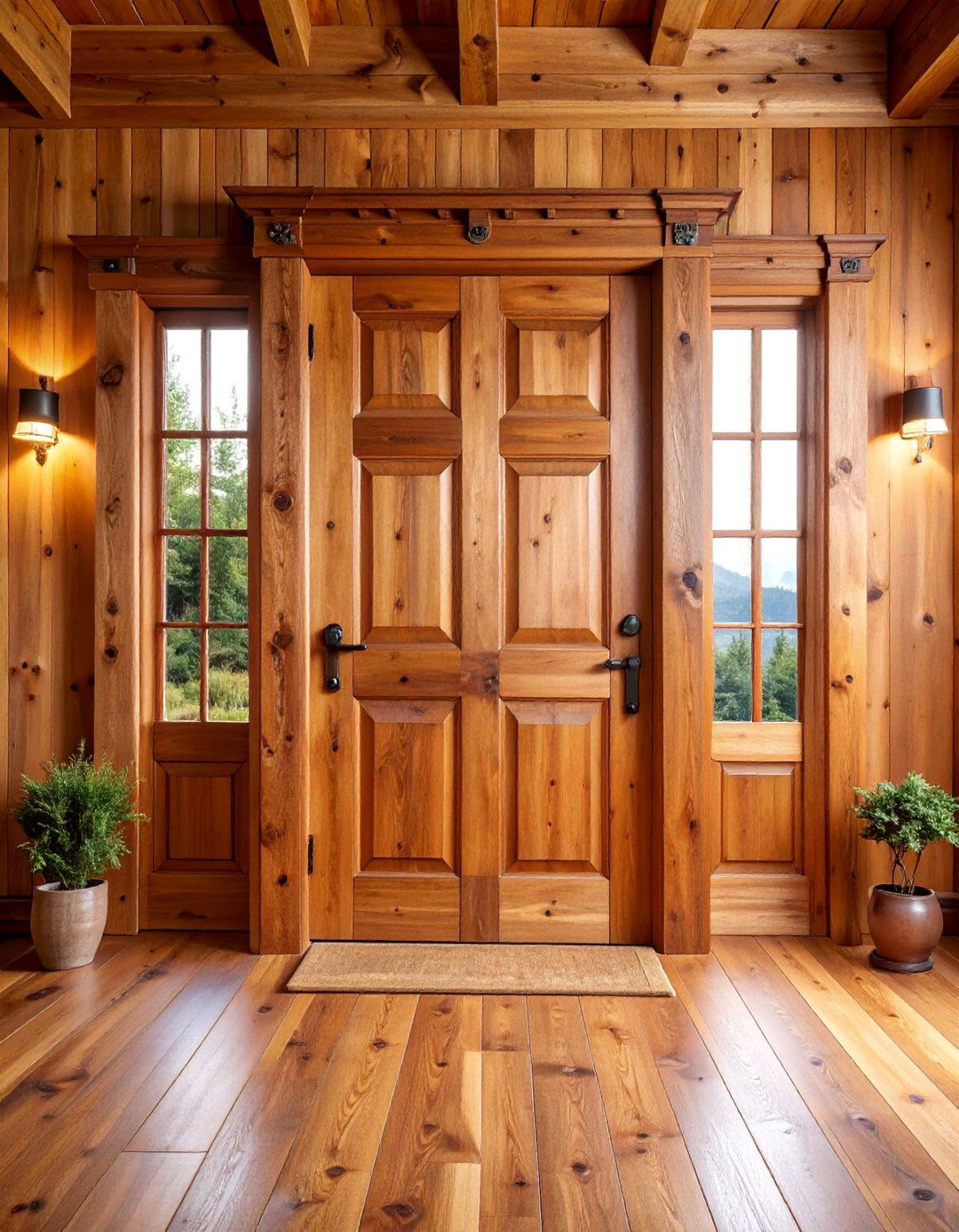
Rustic door trim celebrates natural wood character through boards that showcase visible grain patterns, knots, and organic imperfections that add warmth and authenticity to country-inspired spaces. This approach often uses locally sourced lumber like pine, oak, or cedar with clear protective finishes that allow the wood's natural beauty to shine through. The trim typically features simple profiles with straight edges and butted corners that emphasize the handcrafted aesthetic over formal precision. Stain colors range from light honey tones to rich walnut shades that complement stone fireplaces, exposed beams, and other natural materials. This style works beautifully in cabins, lodges, and homes seeking to bring outdoor elements inside.
8. Art Deco Door Trim with Geometric Elements

Art Deco-inspired door trim incorporates geometric patterns and stepped profiles that reflect the glamorous design movement of the 1920s and 1930s. This distinctive style features angular elements, metallic accents, and bold proportions that create dramatic focal points around doorways. The trim often includes multiple layers with different depths and widths that form stepped or tiered effects reminiscent of skyscraper architecture. Popular finishes include glossy black, deep jewel tones, or metallic paints that catch light and emphasize the geometric forms. This sophisticated approach works particularly well in urban apartments, modern townhomes, and spaces decorated with period furniture, bold artwork, and luxurious materials like marble and velvet.
9. Shaker Style Door Trim with Clean Lines
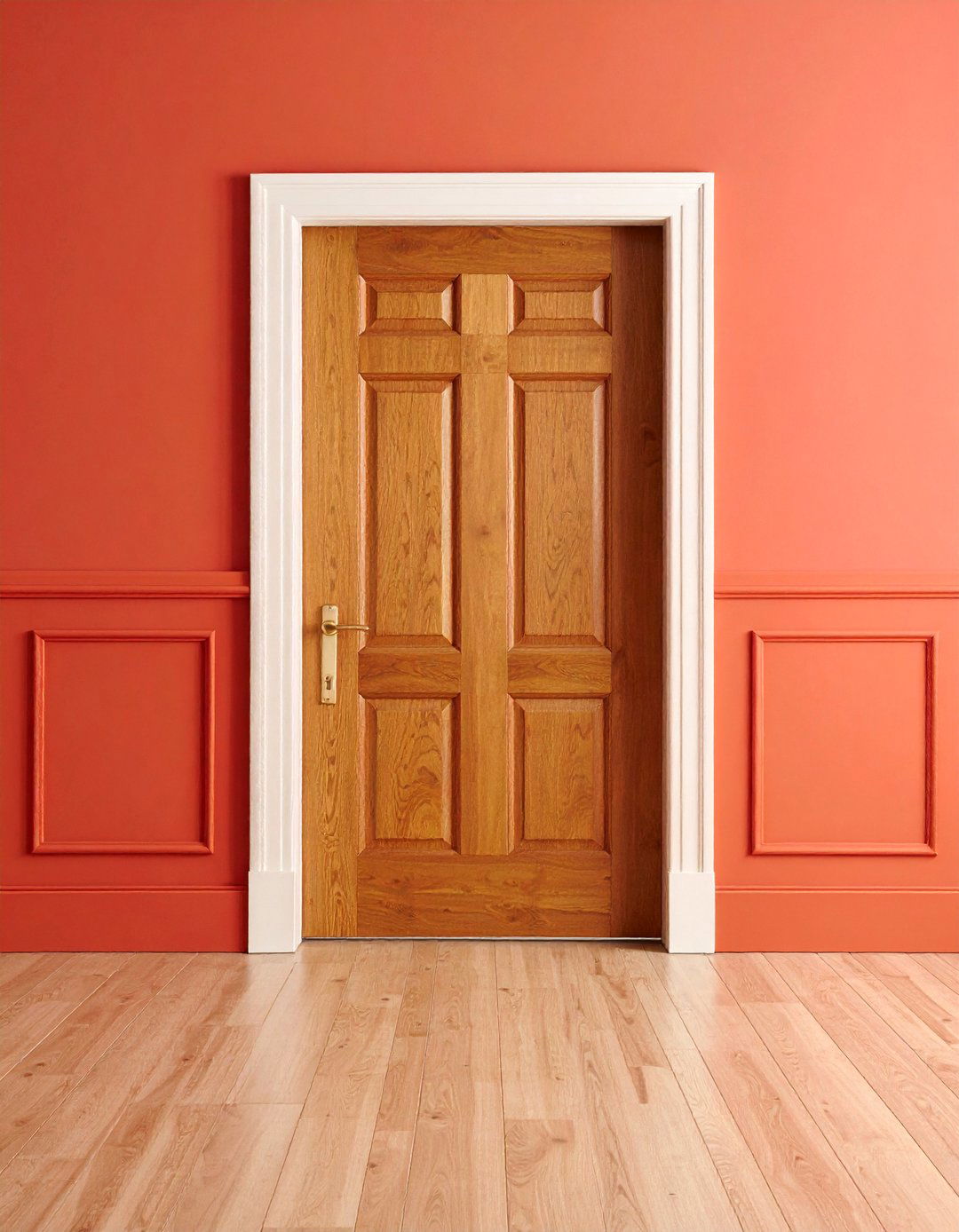
Shaker-inspired door trim reflects the religious community's principles of simplicity and functionality through plain, rectangular boards with minimal ornamentation or decorative elements. This honest approach uses flat boards with square edges and precise mitered corners that create clean, timeless appearances suitable for various decorating styles. The proportions typically feature narrower casings than Craftsman styles but wider than contemporary minimalist approaches, striking a balance between presence and restraint. Traditional finishes include painted whites and soft colors, though modern interpretations embrace bold hues and natural wood stains. This versatile style complements both traditional furniture and contemporary pieces while maintaining the understated elegance that defines Shaker design philosophy.
10. Mediterranean Door Trim with Curved Elements

Mediterranean-style door trim incorporates gentle curves and arched elements that reflect the relaxed, sun-soaked atmosphere of coastal European architecture. This romantic approach often features rounded corners, scalloped edges, or arched headers that soften the geometric lines typical of other trim styles. The trim frequently uses warm wood tones like honey pine or rich walnut that complement terra cotta tiles, wrought iron fixtures, and textured plaster walls. Decorative elements might include carved rosettes with Mediterranean motifs, rope-twist details, or hand-painted accents in blues and golds. This style creates inviting, Old World charm that works beautifully with comfortable furniture, natural fabrics, and collections of pottery or ceramics.
11. Transitional Door Trim with Mixed Profiles
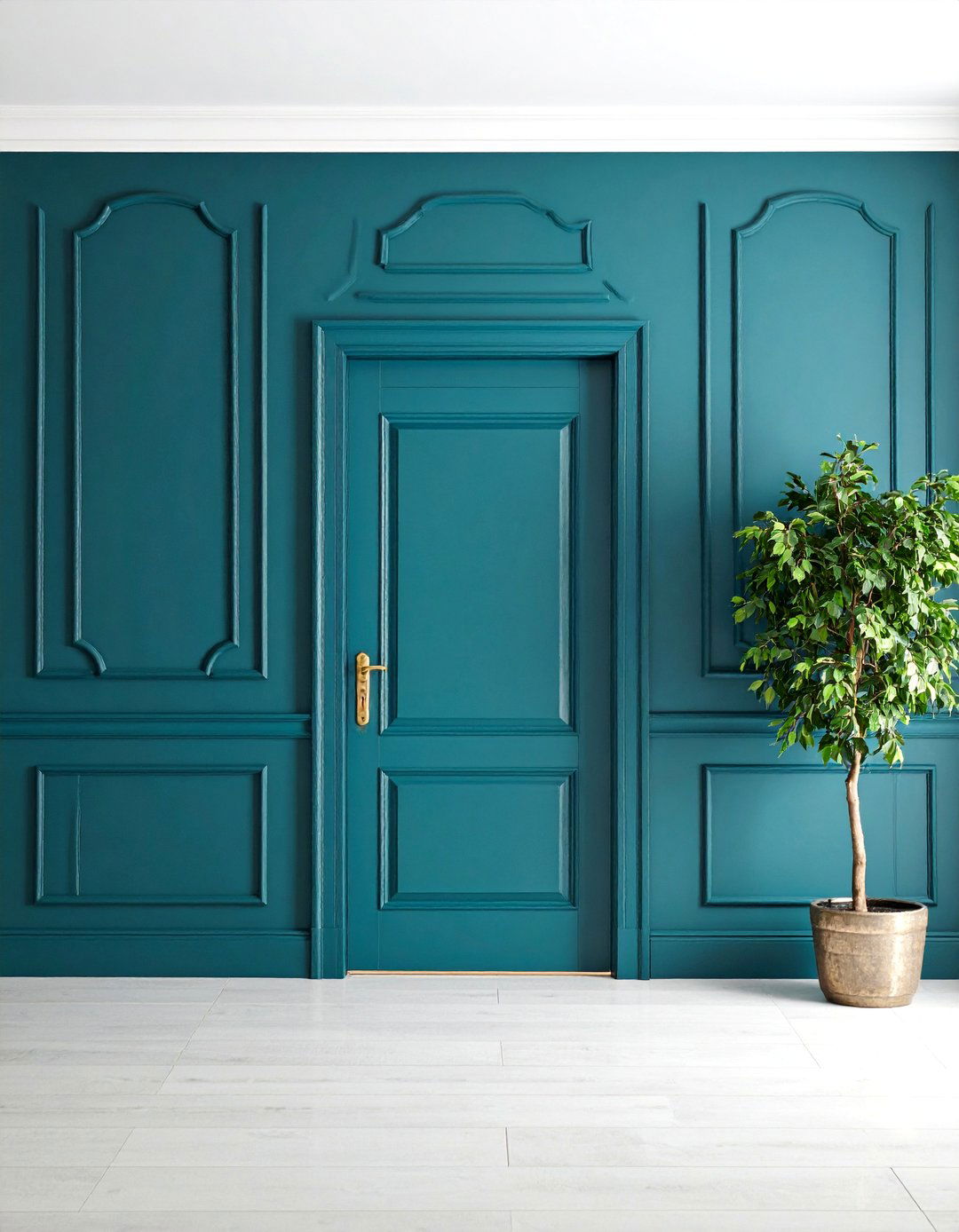
Transitional door trim successfully bridges traditional and contemporary styles by combining classic proportions with simplified profiles that work in diverse decorating schemes. This versatile approach might feature traditional width casings with minimal decorative elements, or contemporary flat boards enhanced with subtle reveals or shadow lines. The style often incorporates elements from multiple periods, such as Craftsman-inspired headers with Colonial-width side casings, creating fresh interpretations of familiar forms. Popular finishes include soft whites, warm grays, and natural wood stains that complement both antique and modern furnishings. This flexible approach allows homeowners to honor architectural history while embracing current design trends and personal preferences.
12. Industrial Door Trim with Metal Accents

Industrial-inspired door trim incorporates metal elements like steel bands, rivets, or angle irons that reference factory and warehouse architecture while adding urban sophistication to residential spaces. This bold approach might feature wood casings with metal corner brackets, steel frames with wooden inserts, or hybrid constructions that combine materials for dramatic contrast. The aesthetic typically embraces raw finishes like brushed steel, aged copper, or powder-coated black that complement exposed brick walls, concrete floors, and vintage lighting fixtures. This style works particularly well in lofts, converted buildings, and modern homes seeking to incorporate architectural salvage or repurposed materials for authentic industrial character and environmental sustainability.
13. French Provincial Door Trim with Ornate Details

French Provincial door trim captures the refined elegance of 18th-century French country estates through gracefully curved profiles and delicate decorative elements that create sophisticated focal points. This romantic style often features flowing curves, floral motifs, and subtle asymmetrical elements that reflect the influence of Rococo design on rural French architecture. The trim typically uses pale colors like cream, soft blue, or sage green with distressed finishes that suggest age and history. Decorative elements might include carved acanthus leaves, ribbon details, or small rosettes with flower patterns. This luxurious approach complements antique furniture, toile fabrics, and crystal chandeliers while creating gracious, European-inspired atmospheres that feel both formal and welcoming.
14. Modern Black Door Trim for Bold Contrast
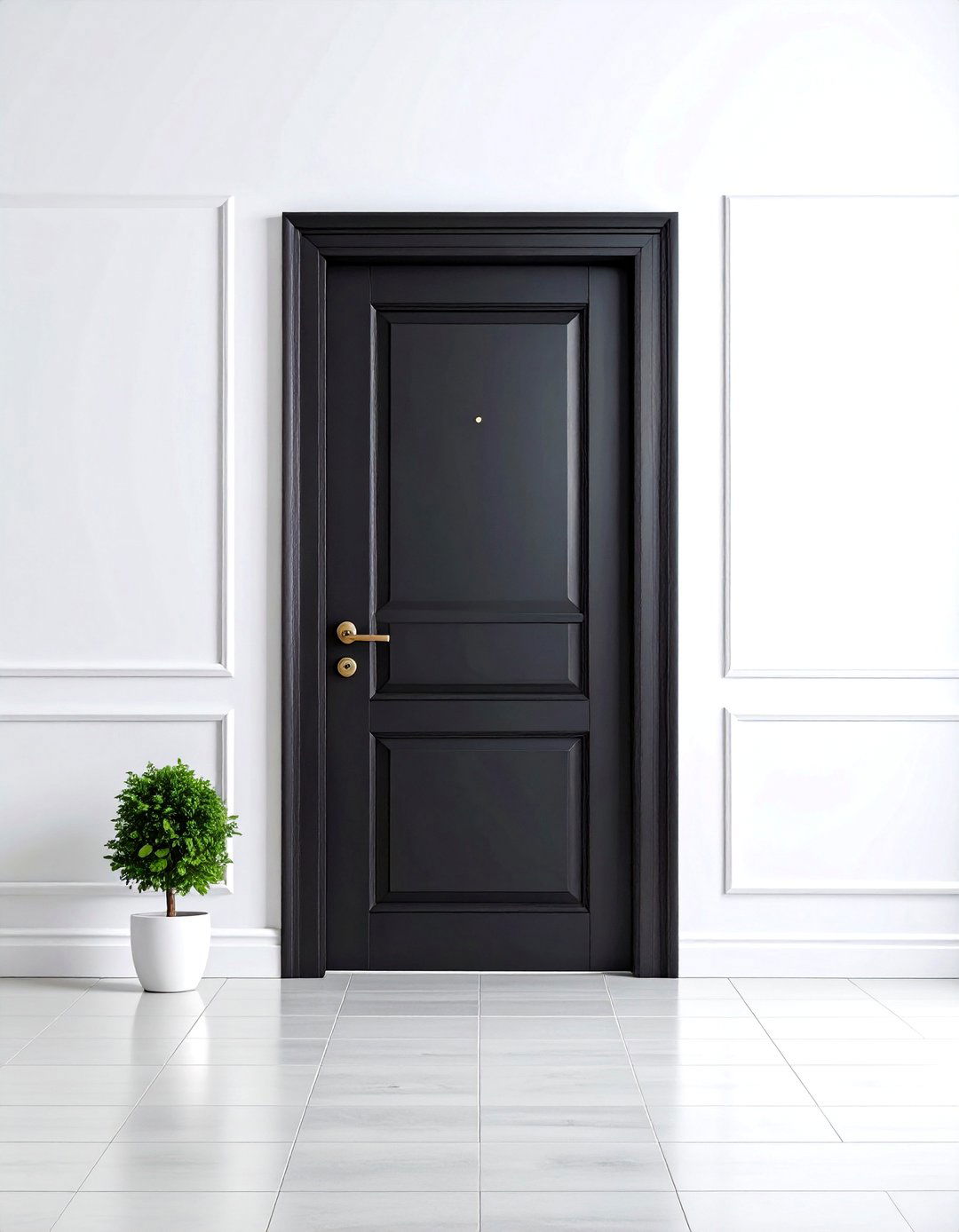
Contemporary black door trim creates striking focal points that frame doorways with sophisticated drama while providing bold contrast against light-colored walls and contemporary furnishings. This confident choice works particularly well with white or light gray walls, creating graphic compositions that emphasize architectural geometry and spatial relationships. The dark color helps define room boundaries in open floor plans while adding visual weight that anchors furniture groupings and artwork. Popular profiles include flat boards, simple rectangles, or minimally detailed casings that maintain clean lines without competing with the bold color statement. This approach complements modern artwork, sleek furniture, and metallic accents while creating gallery-like sophistication in residential settings.
15. Cottage Style Door Trim with Painted Finishes

Cottage-style door trim embraces charming imperfection through slightly irregular profiles, hand-painted finishes, and cheerful colors that create welcoming, lived-in atmospheres reminiscent of English country homes. This relaxed approach often features moderate-width casings with gentle curves or beaded edges that add subtle detail without formal pretension. Popular color choices include soft pastels, warm whites with visible brush strokes, or distressed finishes that suggest years of loving use. The style often incorporates mismatched elements or slightly varied proportions that enhance the handcrafted character. This approachable aesthetic works beautifully with vintage furniture, floral fabrics, and collections of pottery or folk art while creating cozy spaces that invite relaxation and casual entertaining.
16. Asian-Inspired Door Trim with Horizontal Elements

Asian-influenced door trim emphasizes horizontal lines and geometric simplicity that reflect the principles of balance and harmony found in Japanese and Chinese architectural traditions. This serene approach often features flat boards arranged in grid patterns, horizontal emphasis pieces, or stepped profiles that create rhythmic visual elements around doorways. The style typically uses natural wood finishes in warm tones like bamboo, teak, or cherry that complement tatami mats, paper screens, and minimalist furnishings. Decorative elements remain subtle and geometric rather than ornate, focusing on proportion and material quality over elaborate ornamentation. This peaceful aesthetic creates calming environments that emphasize natural light, spatial flow, and the beauty found in architectural restraint.
17. Prairie Style Door Trim with Horizontal Emphasis
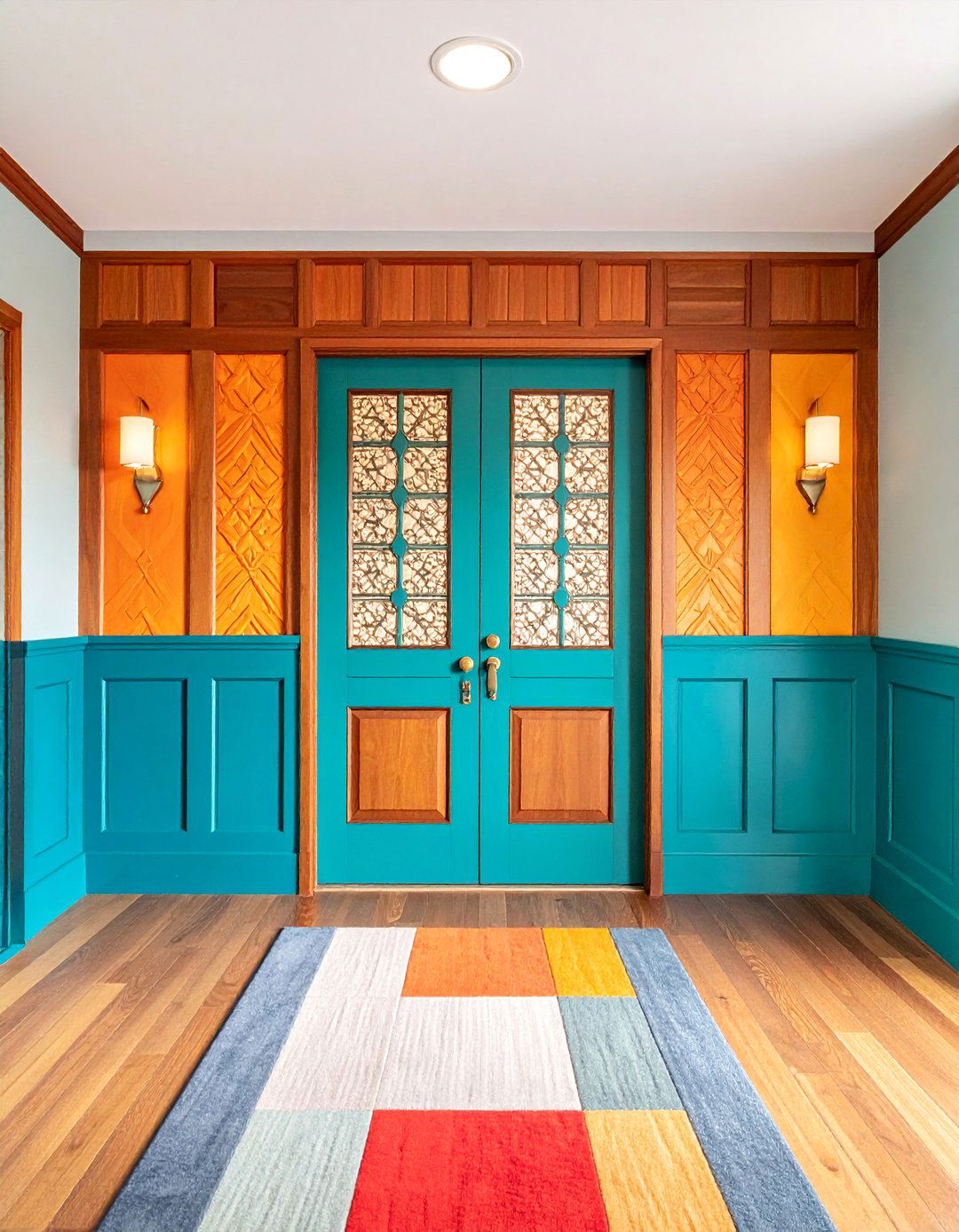
Prairie School door trim reflects Frank Lloyd Wright's architectural philosophy through strong horizontal lines and geometric patterns that echo the flat Midwestern landscape and emphasize connection with nature. This distinctive style features wide, flat boards with minimal decorative elements, often incorporating multiple horizontal bands or stepped profiles that create rhythmic shadow patterns. The trim typically extends beyond standard proportions to emphasize horizontal movement and spatial flow between rooms. Popular finishes include natural wood stains in rich colors like walnut or mahogany that complement earth-tone color schemes and natural materials. This architectural approach works beautifully in ranch homes, contemporary designs, and spaces seeking to blur boundaries between indoor and outdoor living areas.
18. Southwestern Door Trim with Adobe-Style Elements
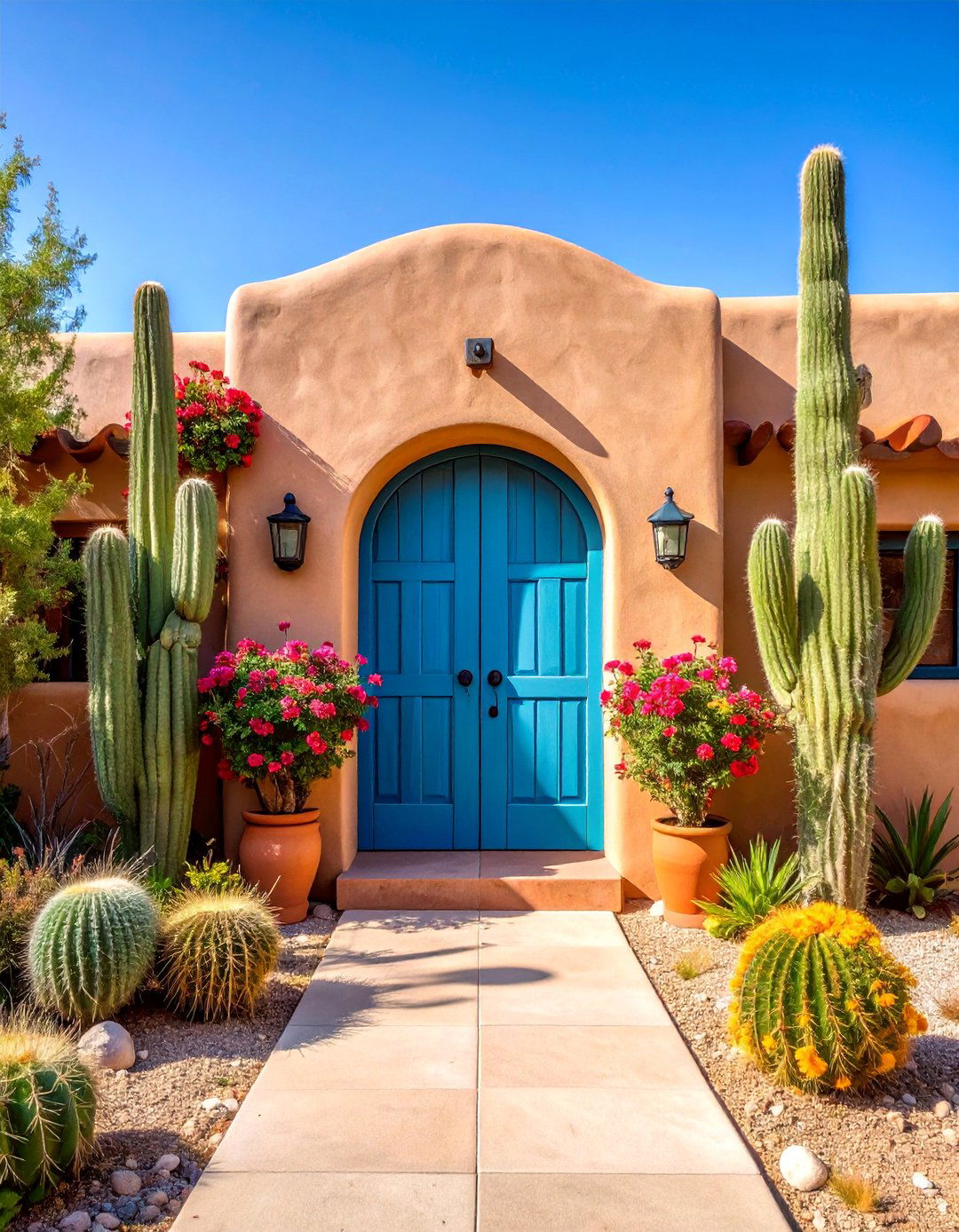
Southwestern door trim incorporates rounded edges, earth-tone colors, and textural elements that reference traditional adobe construction and desert landscapes of the American Southwest. This warm approach often features curved corners, rough-hewn surfaces, or hand-carved details that suggest handcrafted construction methods and regional building traditions. Popular colors include warm terracotta, sage green, turquoise, and natural wood tones that complement tile floors, exposed vigas, and Native American textiles. Decorative elements might include stylized petroglyphs, geometric patterns, or nature motifs like saguaro cacti or desert flowers. This regional style creates relaxed, welcoming atmospheres that celebrate local culture while providing comfortable shelter from harsh desert climates through thick walls and protective overhangs.
19. Scandinavian Door Trim with Light Colors

Scandinavian-inspired door trim emphasizes light colors, clean lines, and natural materials that reflect the Nordic design philosophy of creating bright, welcoming spaces during long, dark winters. This practical approach typically features simple profiles in white, pale gray, or natural blonde wood finishes that maximize light reflection and create airy, spacious feelings. The trim proportions remain moderate, avoiding both excessive ornamentation and stark minimalism to achieve comfortable, human-scaled environments. Natural wood options often showcase light species like pine, birch, or ash with clear finishes that highlight subtle grain patterns. This wholesome aesthetic complements modern furniture, neutral textiles, and potted plants while creating serene environments that emphasize comfort, functionality, and connection with nature.
20. Mid-Century Modern Door Trim with Sleek Profiles
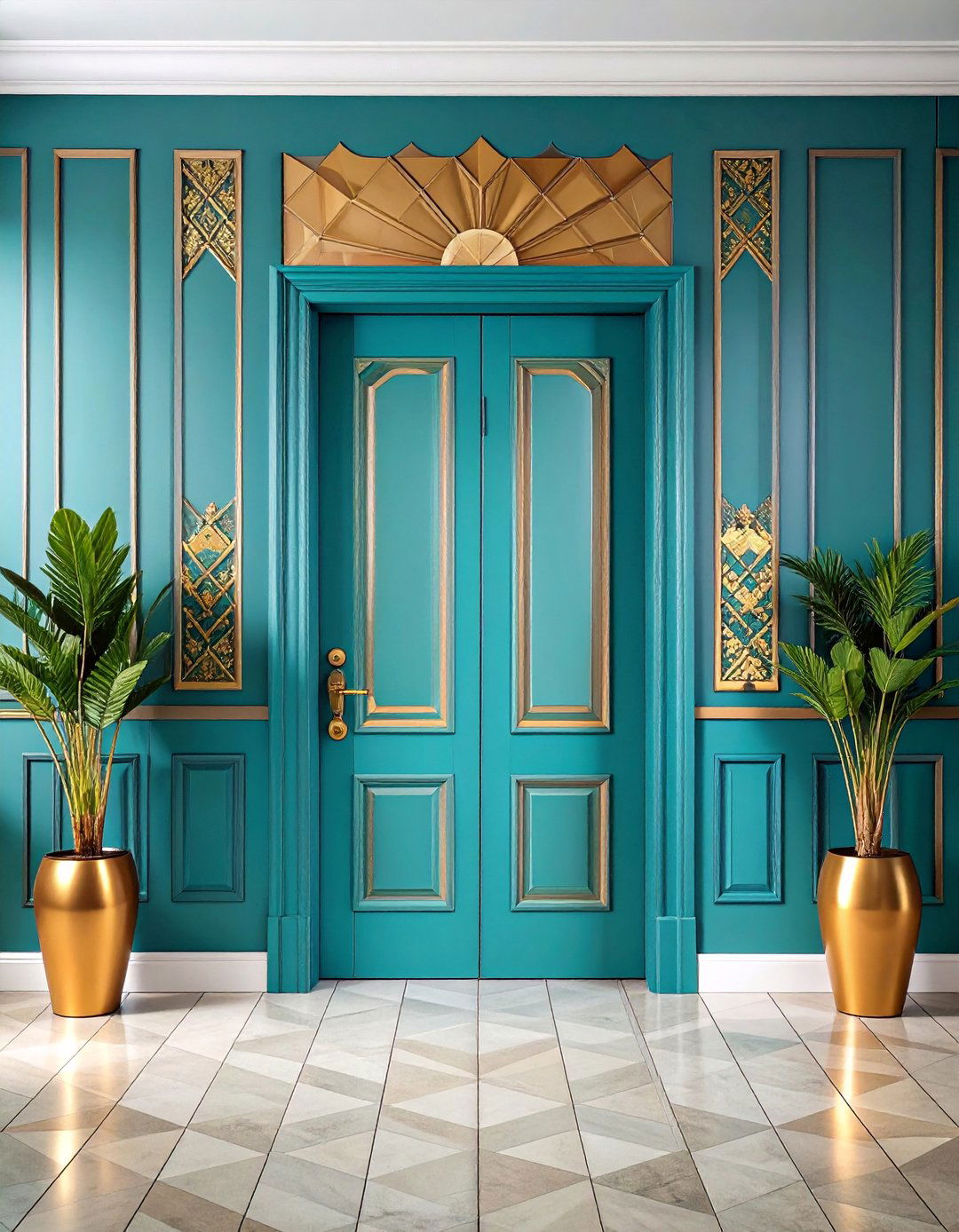
Mid-Century Modern door trim captures the optimistic design spirit of the 1950s and 1960s through streamlined profiles, geometric forms, and integration with architectural elements like room dividers and built-in storage. This forward-looking style often features flat boards with sharp edges, angular corners, or stepped profiles that create clean shadow lines and emphasize spatial geometry. Popular materials include teak, walnut, or painted finishes in period colors like avocado green, orange, or turquoise that complement boomerang patterns, atomic motifs, and sleek furniture designs. The trim often extends to create visual connections with other architectural elements, helping to unify open floor plans and emphasize the indoor-outdoor living concepts that defined the era.
21. English Tudor Door Trim with Dark Wood Details

English Tudor door trim celebrates the medieval architectural revival through dark wood finishes, substantial proportions, and decorative elements that reference half-timbered construction and Gothic design principles. This dramatic style often features heavy oak or walnut casings with carved details, metal hardware, and rich stain finishes that create formal, castle-like atmospheres. The trim proportions typically emphasize vertical elements with pointed arch influences, diamond-shaped panels, or linenfold patterns that add textural interest and historical authenticity. Popular colors include deep browns, burgundy, and ebony finishes that complement leaded glass windows, tapestry fabrics, and wrought iron fixtures. This grand approach creates impressive entrances and formal room definitions while honoring English architectural traditions and craftsmanship heritage.
22. Coastal Door Trim with Weathered Finishes
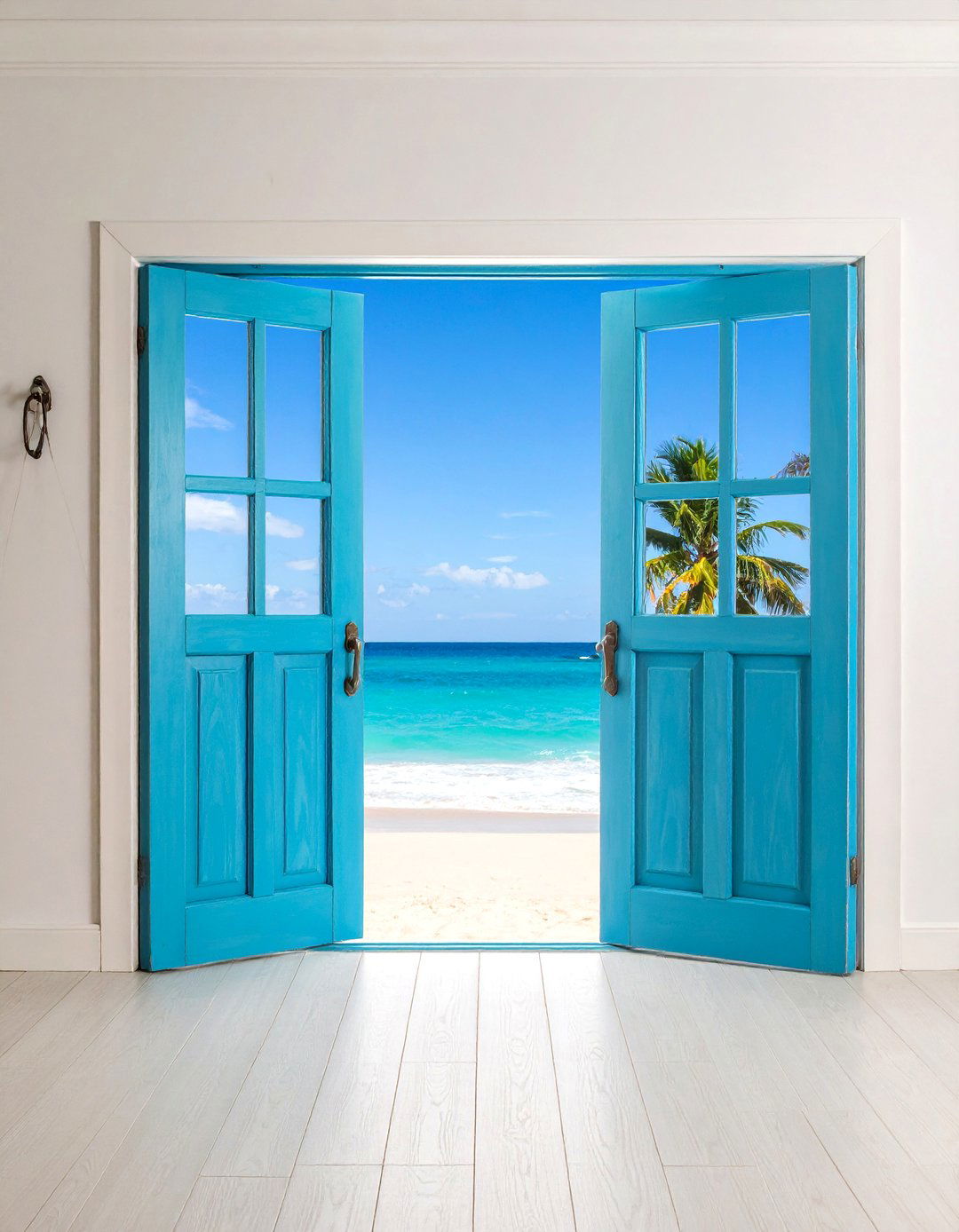
Coastal door trim captures the relaxed atmosphere of seaside living through weathered finishes, nautical elements, and colors inspired by sand, sea, and sky that create vacation-like environments year-round. This casual approach often features distressed paint techniques, bleached wood effects, or rope details that suggest exposure to salt air and ocean weather. Popular color choices include soft blues, sandy beiges, driftwood grays, and crisp whites that complement seashell collections, wicker furniture, and nautical accessories. The trim profiles typically remain simple and unpretentious, focusing on comfort and relaxation rather than formal elegance. This breezy aesthetic works beautifully in beach houses, lakefront properties, and urban homes seeking to capture coastal charm through thoughtful material choices and color palettes.
23. Gothic Revival Door Trim with Pointed Arch Elements

Gothic Revival door trim incorporates pointed arches, tracery patterns, and vertical emphasis that reference medieval cathedral architecture while creating dramatic, romantic atmospheres in residential settings. This ornate style often features carved stonework patterns translated into wood, pointed arch headers, and intricate geometric details that add architectural grandeur to doorways. The trim typically uses dark wood finishes or painted surfaces in deep colors like burgundy, forest green, or midnight blue that complement stained glass windows, tapestry wall coverings, and antique furnishings. Decorative elements might include trefoil patterns, rose windows, or flying buttress-inspired brackets that create authentic period character. This theatrical approach works beautifully in libraries, formal dining rooms, and spaces seeking to create mysterious, scholarly atmospheres.
24. Contemporary Floating Door Trim with Shadow Gaps

Contemporary floating door trim creates modern, architectural interest through shadow gaps and reveals that make trim appear to float away from walls while emphasizing clean geometric relationships. This sophisticated technique uses precise installation methods to create consistent gaps between trim elements and wall surfaces, resulting in dramatic shadow lines that change throughout the day as light conditions shift. The approach typically features flat boards with sharp edges and minimal profiles that maintain focus on spatial relationships rather than decorative details. Popular finishes include matching trim and wall colors to emphasize form over material contrast, or bold color combinations that highlight the geometric interplay. This cutting-edge style complements contemporary furniture, abstract artwork, and open floor plans that emphasize architectural drama.
25. Traditional Plantation Style Door Trim with Wide Boards

Plantation-style door trim reflects Southern architectural traditions through substantial proportions, classical details, and refined finishes that create gracious, formal atmospheres reminiscent of antebellum mansions and estate homes. This elegant approach typically features wide casings with traditional profiles, fluted columns, or pilaster details that reference Greek Revival and Colonial influences. The trim often incorporates cornices, capitals, and bases that create complete classical orders around important doorways like formal entrances or dining room openings. Popular finishes include painted whites and soft colors that complement shuttered windows, hardwood floors, and traditional furnishings. This stately style emphasizes hospitality and gracious living while honoring regional architectural heritage through authentic proportions, materials, and craftsmanship details that create lasting impressions.
Conclusion:
The right door trim choice transforms ordinary doorways into architectural focal points that enhance your home's character and value. From traditional Victorian elegance with decorative rosettes to sleek contemporary floating trim with shadow gaps, each style offers unique opportunities to express personal taste while complementing existing architectural features. Whether embracing bold contrast with modern black trim or creating seamless continuity through color-drenched techniques, thoughtful trim selection elevates interior design while providing functional benefits like hiding construction gaps and protecting wall edges. Consider your home's architectural style, room proportions, and lifestyle preferences when selecting trim designs that will provide lasting beauty and satisfaction for years to come.


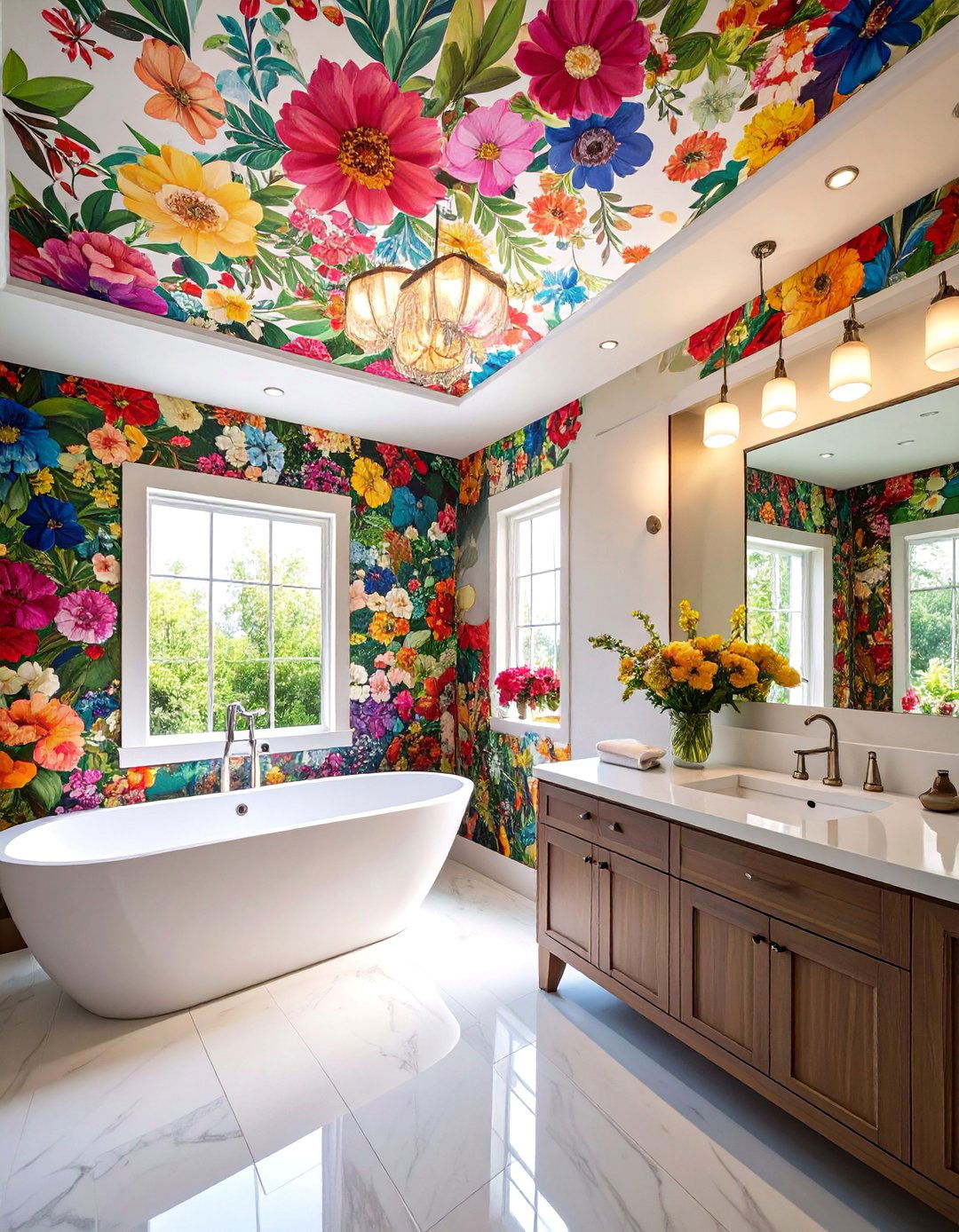
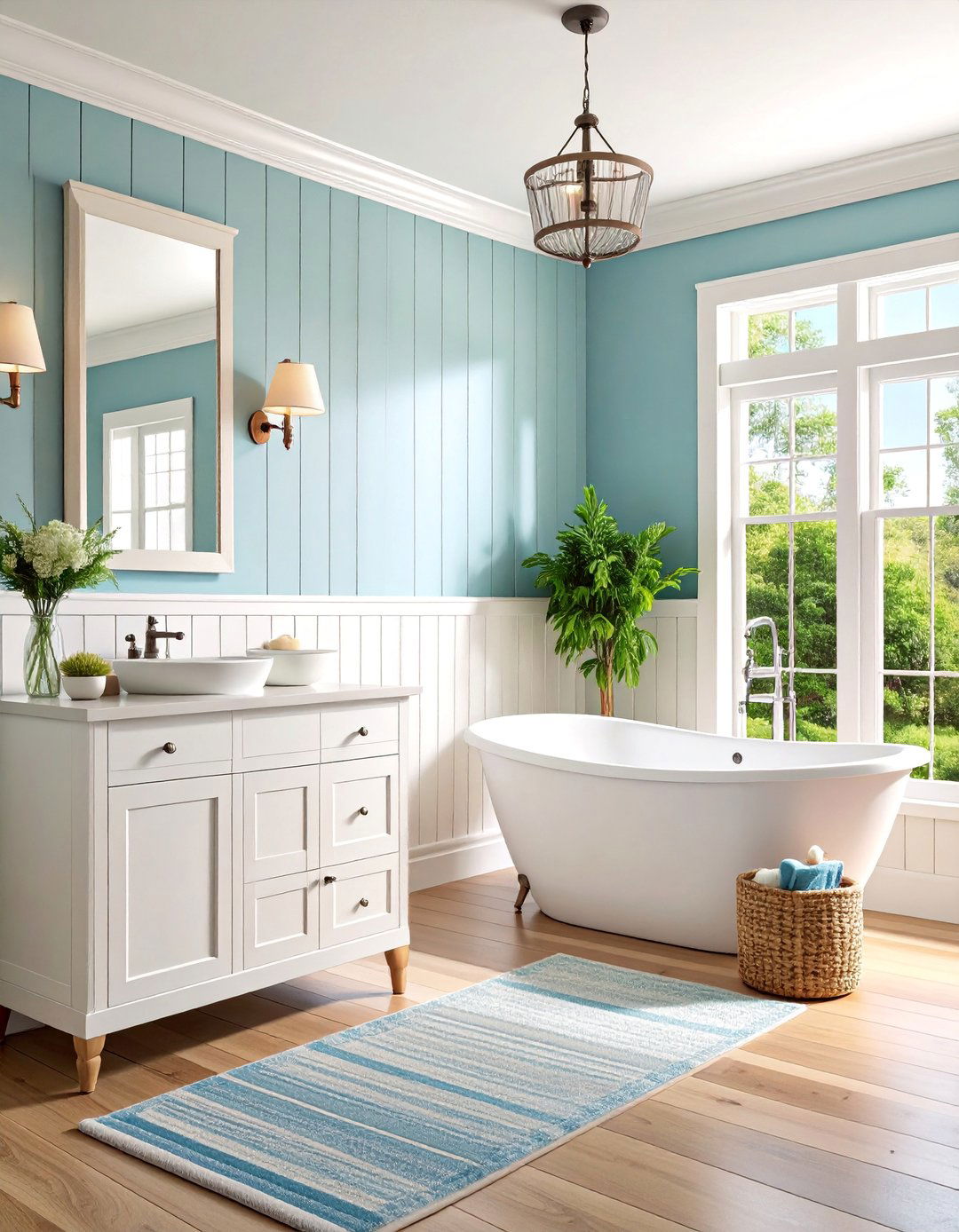
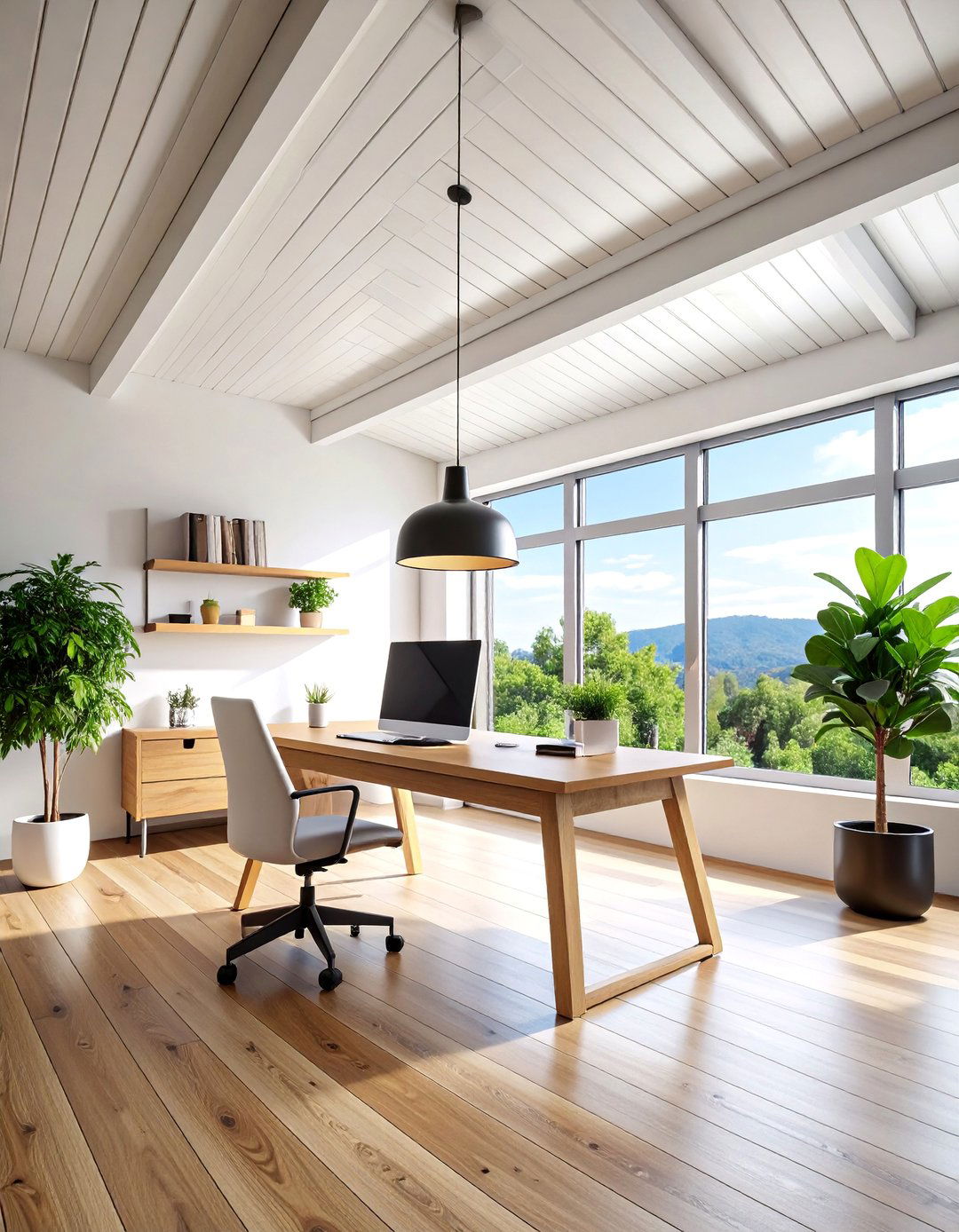



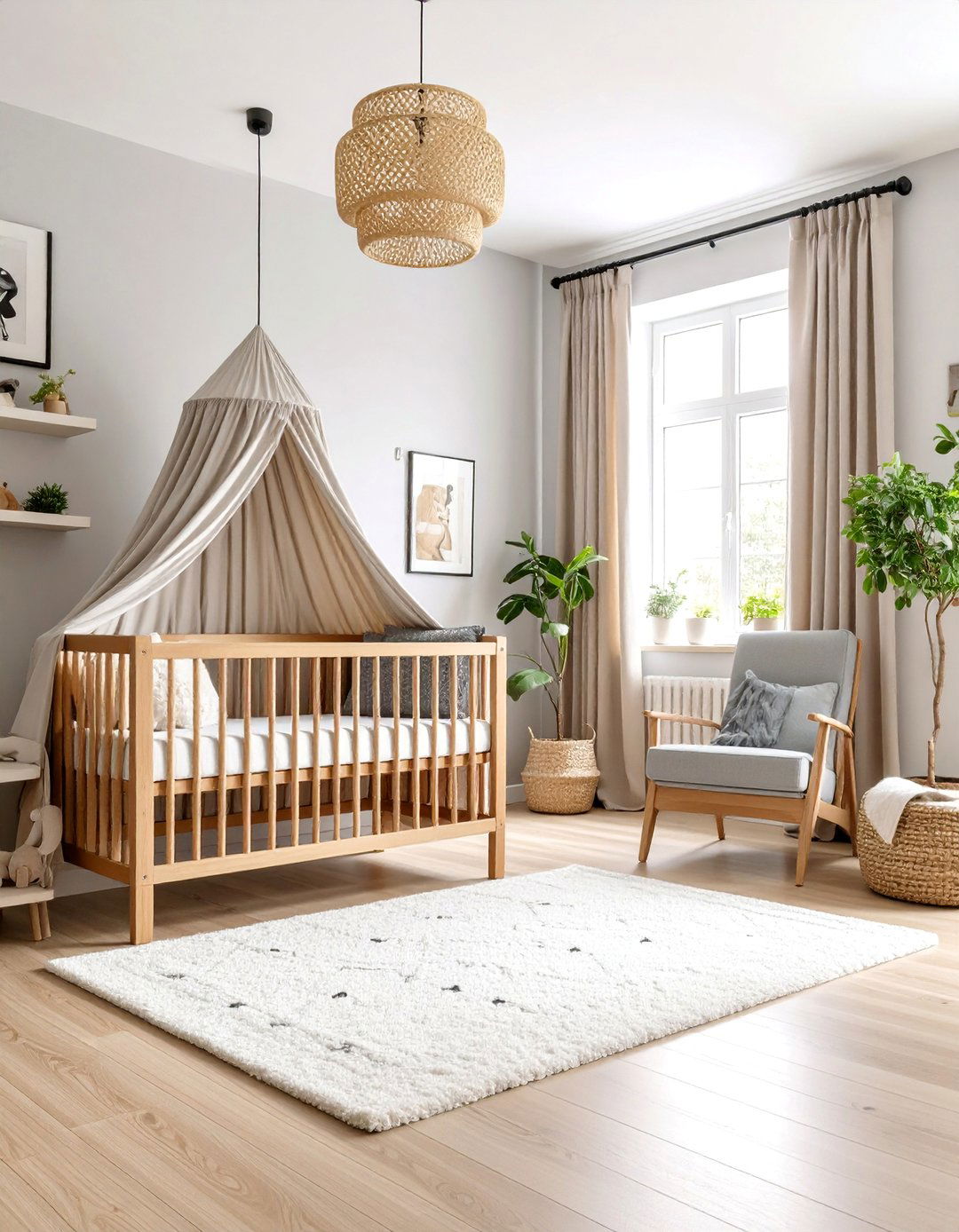
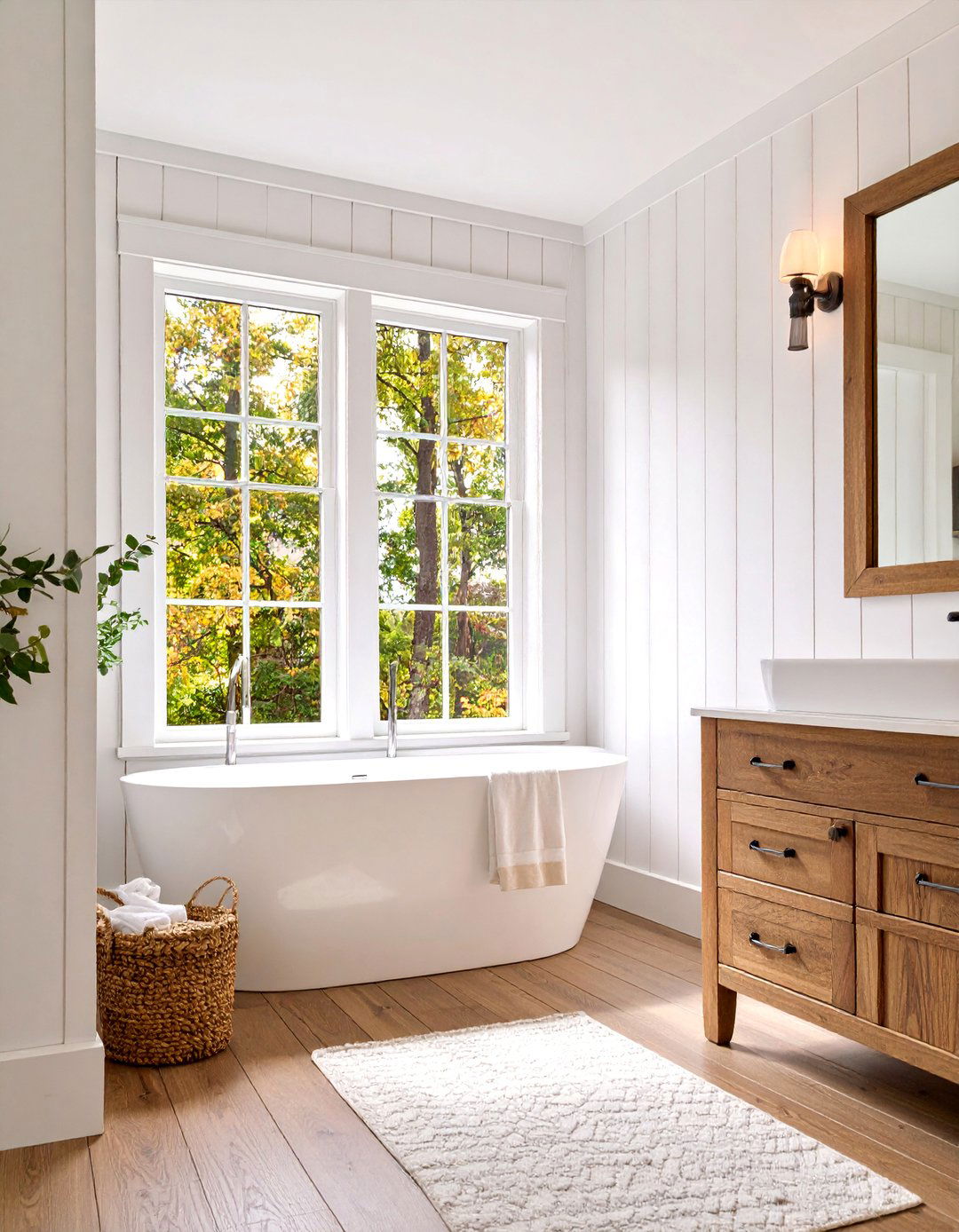
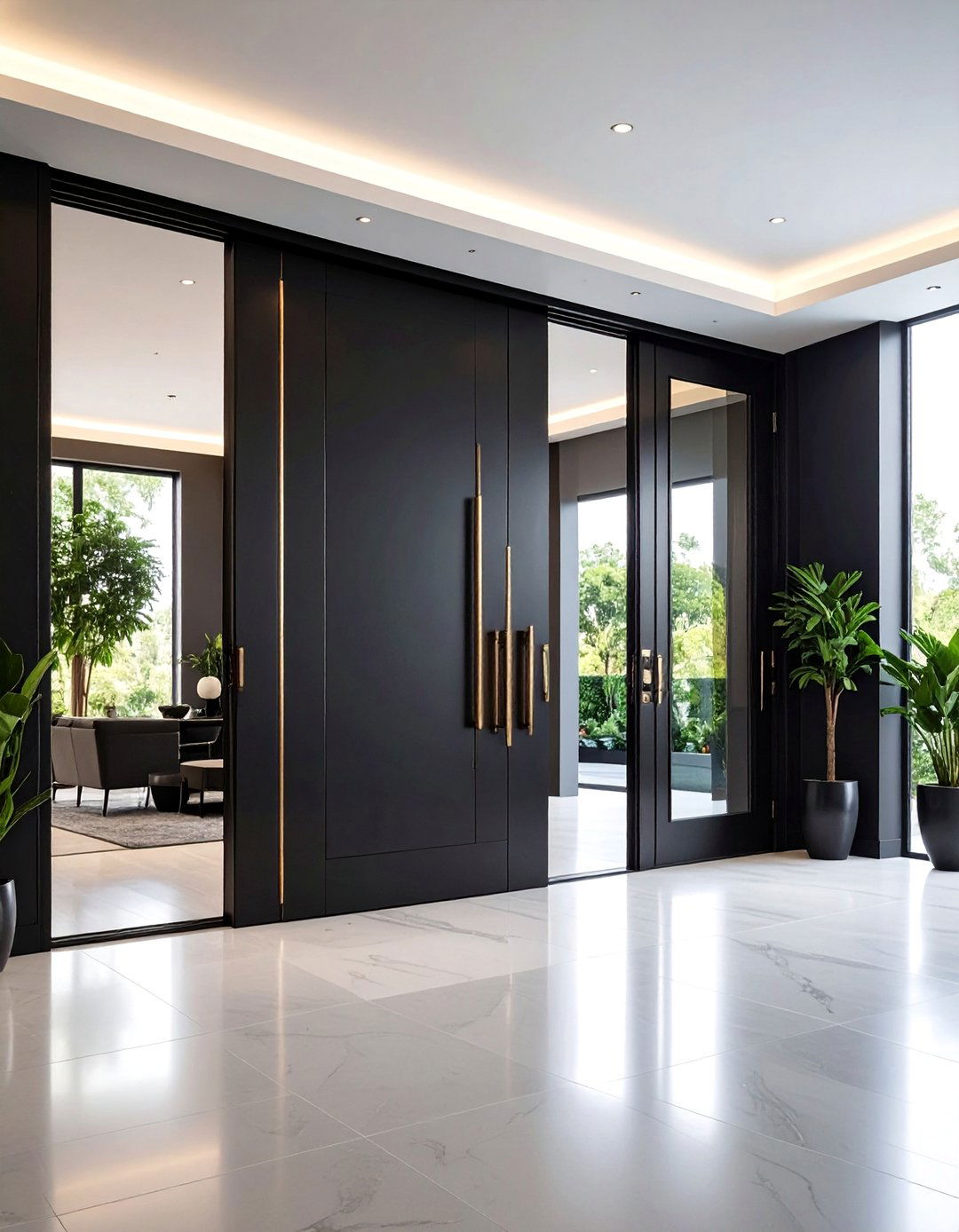
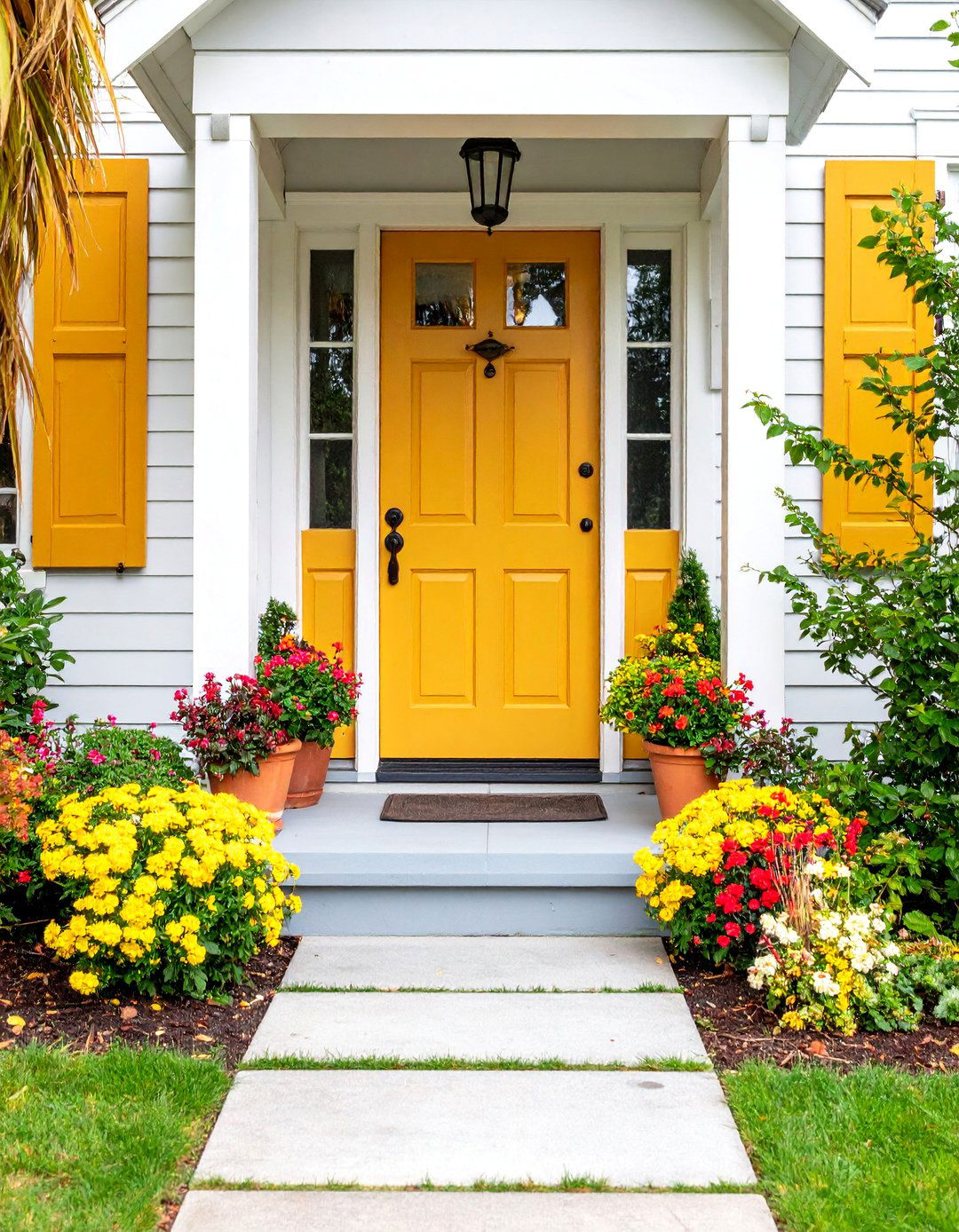
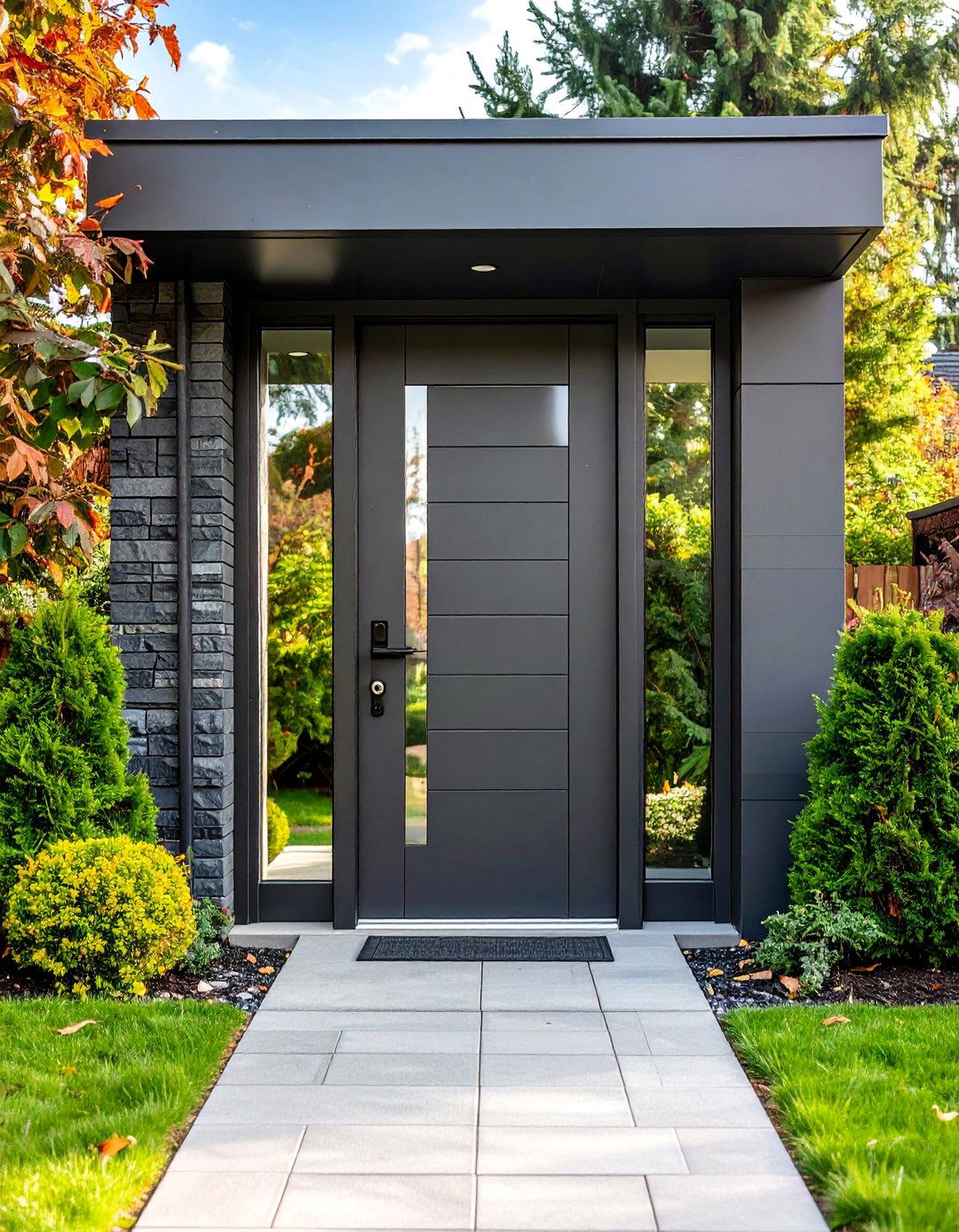
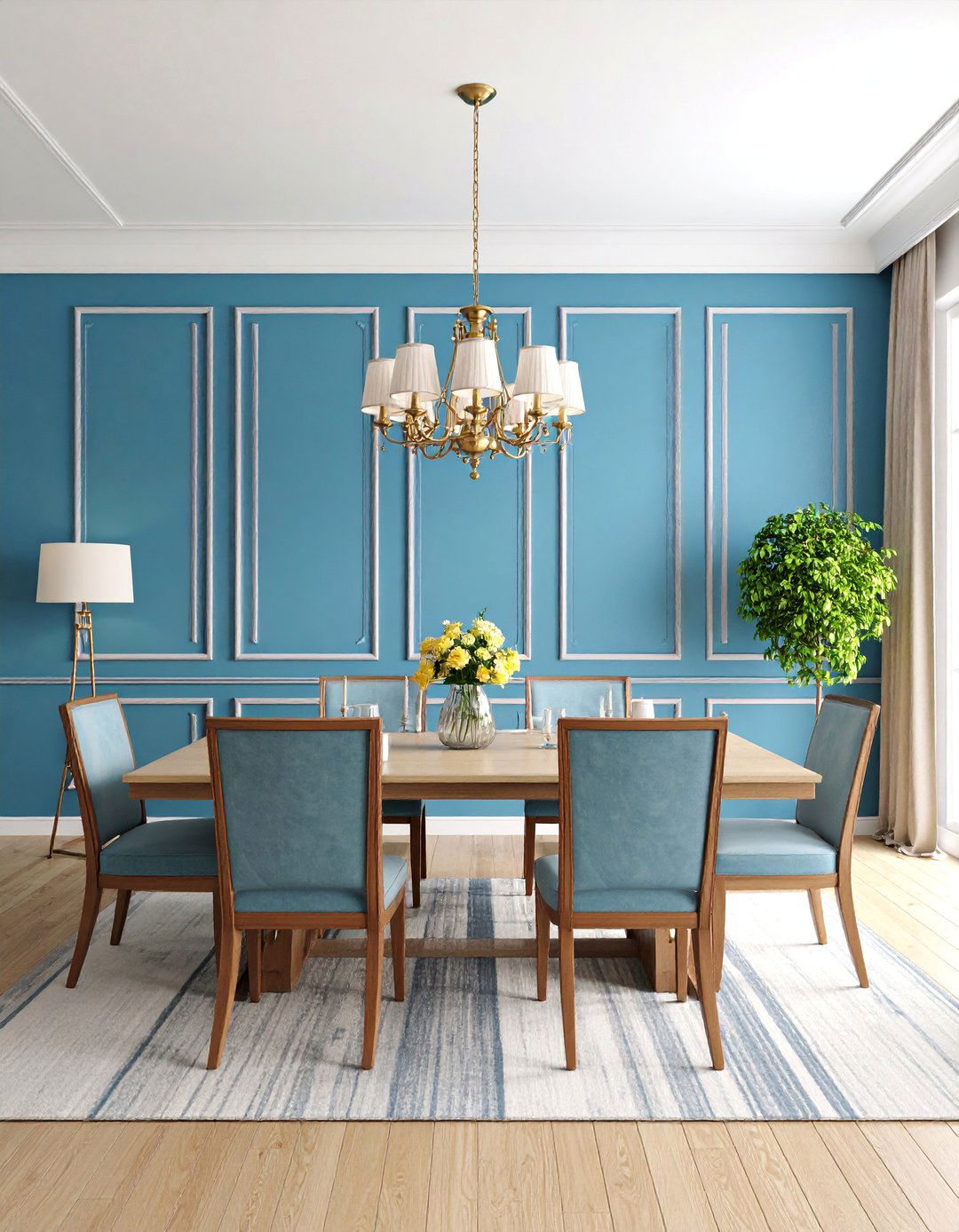



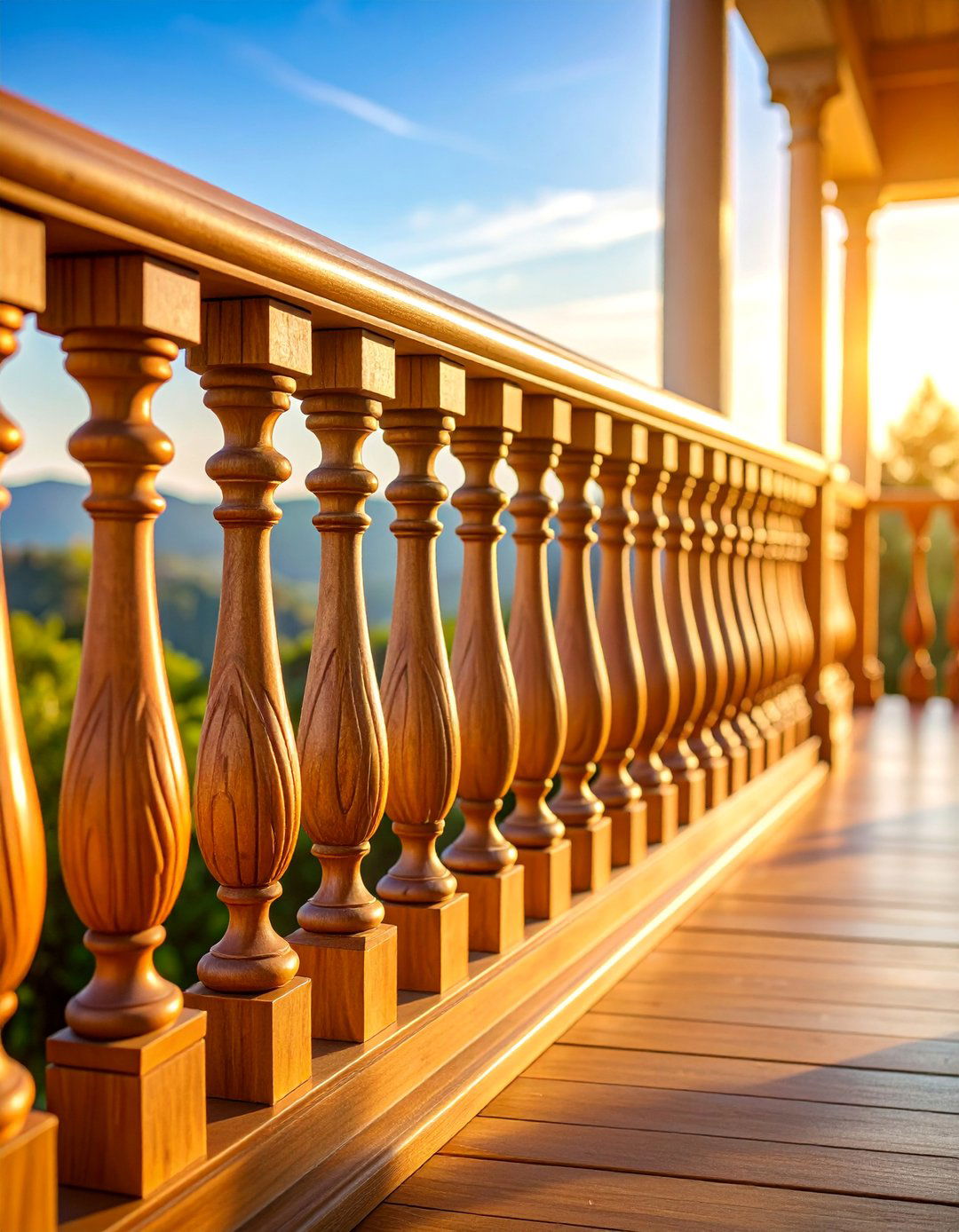
Leave a Reply